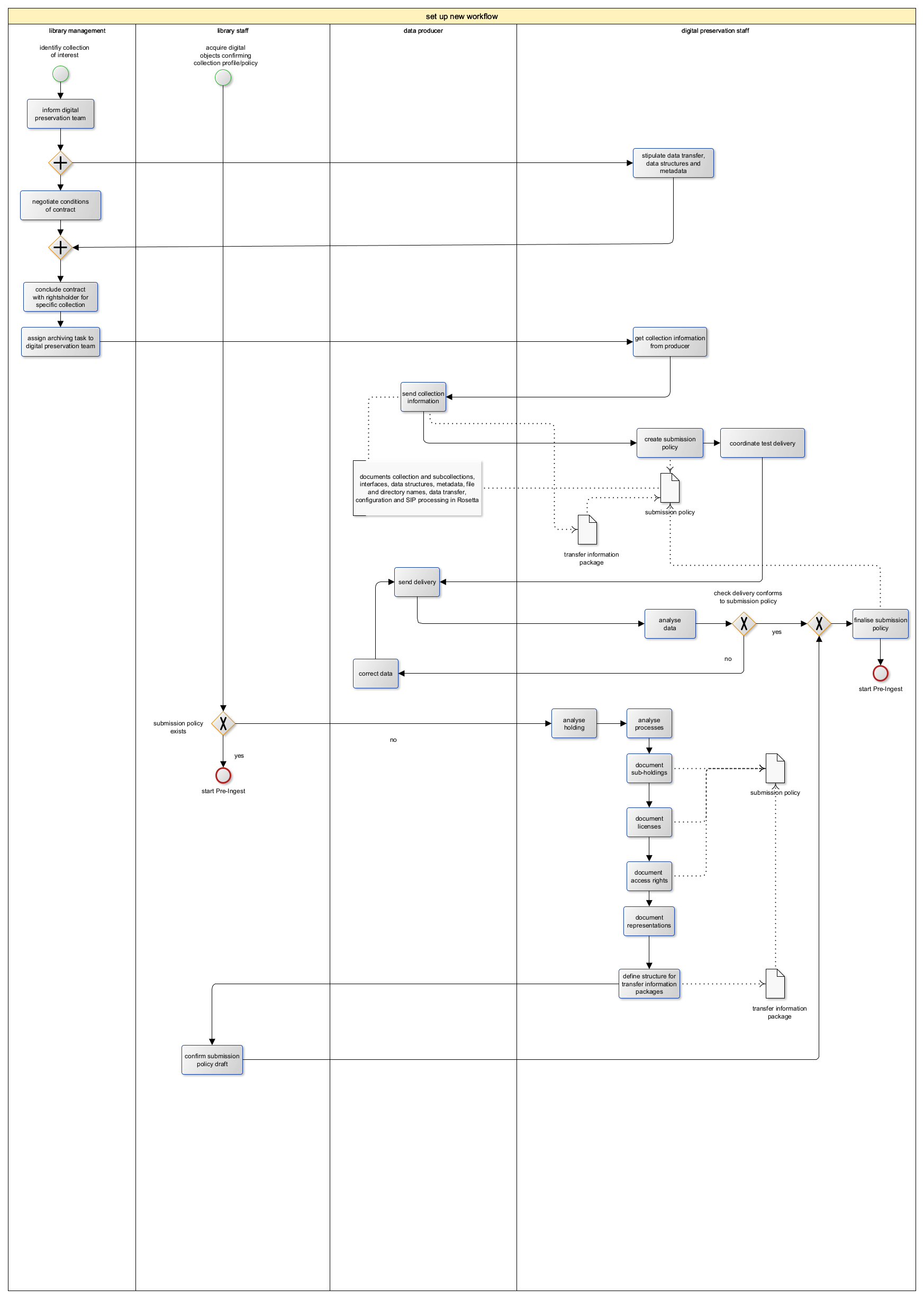Versionen im Vergleich
Schlüssel
- Diese Zeile wurde hinzugefügt.
- Diese Zeile wurde entfernt.
- Formatierung wurde geändert.
Content
| Inhalt | ||||
|---|---|---|---|---|
|
Further information
Specifications for submission information packages (SIP)
Preparation
of objects during the pre-ingest processfor the connection of new workflows
Depending on the collection, the librarians or the long-term archiving team coordinate the delivery The librarians coordinate deliveries to the library with the producers. The Technische Informationsbibliothek (TIB) – German National Library of Science and Technology (TIB) has published guidelines on for special delivery requirements governing delivery. Examples include the Delivery Agreement on BMBF Research Reports , for example the delivery agreement for BMBF research reports (Federal Ministry of Education and Research) (in German) and guidelines on Submitting doctoral theses (in German).
In cooperation with the Digital Preservation team, acquisition teams prepare their objects for digital preservation during pre-ingest. The Process diagram: Pre-ingest below describes the pre-ingest process using the example of creating an METS transfer structure.
or for the submission of a dissertation.
The long-term archiving team carries out an inventory and process analysis before taking over new inventory groups. On the basis of these analyses, holdings groups, publication types, license texts and access rights are documented. The data determined forms the basis for the workflow configurations in the digital long-term archiving system. The new workflow process diagram describes the procedure for developing new workflows.
The long-term archiving team concludes a Template for submission policies with the responsible acquisitions team or directly with the data provider for all holdings to be transferred.
Preparation of objects during the pre-ingest process
The acquisitions teams prepare their objects for long-term archiving in cooperation with the long-term archiving team in the pre-insert phase. The long-term archiving team agrees a data structure for delivery with data providers who deliver directly to the long-term archiving team.
The pre-ingest process diagram below describes the pre-ingest process for holdings that are delivered directly to the relevant library teams and to the long-term archiving team.
The film digitization process diagram documents the preparatory work for digitization, the subsequent quality control during acceptance and the preparation of the film digitized material for transfer.
In the case of open access e-journals, the long-term archiving team collects the data directly from the data source. These objects are prepared using the retrieval script, for example the Hindawi Journal Downloader (HinJodL).
The resulting packages are taken over by the long-term archiving team in a defined cycle and are described as inbound package structures. The following inbound package structures The packages created in this way are submitted by the Digital Preservation team at defined intervals, and are described as transfer information packages. The following transfer information packages are specified:
- SIPs with a simple structure and one representation
SIPs with a simple structure structures can be submitted either as ZIP files or as foldersa single file or as a folder. The ingest takes place as a METS-Deposit. - Objects with multiple representations or complex data structures file repositories
for For objects with multiple representations or complex data structuresfile repositories. The ingest takes place as a METS deposit. - Repository connection Connection to the repository via OAI or via another interface
- Objects with metadata from source systems or complex relationships between data packages
for objects with metadata from source systems or complex relationships between data packages. The ingest takes place as a CSV deposit.
Before automatic METS or CSV depositions of a dataset from TIB library teams, the long-term archiving team carries out a preliminary analysis that includes at least Before data are automatically ingested, the Digital Preservation team conducts a preliminary analysis, which involves the following steps:
- Checking for completeness of submitted datathe transferred dataset for completeness, conformity with the SIP specification, for example with the Pre-Ingest Analyzer (TIB in-house development)
- Checking the recorded structural and legal metadata recorded by the responsible acquisition teamfor completeness
- Pre-analysis of the transferred database: Identification Preliminary analysis of submitted data: identification and validation of the objects , and documentation of the results with sf-DROID-JHOVE (in-house development TIB)
After the ingest, a A second analysis is conducted after ingestcarried out; the results of the two analyses are matched.compared.
Exceptions to this are fully automated connections via OAI interfaces such as those set up for the institutional repository of Leibniz Universität Hannover, the University Publications team and the Open Access e-journals.
| Anker | ||||
|---|---|---|---|---|
|
Please click to enlarge
 Image Added
Image Added
Anker PPI PPI
Process diagram Pre-Ingest
| PPI | |
| PPI |
Please click to enlarge
 Image Modified
Image Modified
| Anker | ||||
|---|---|---|---|---|
|
Please click to enlarge Image Added
Image Added